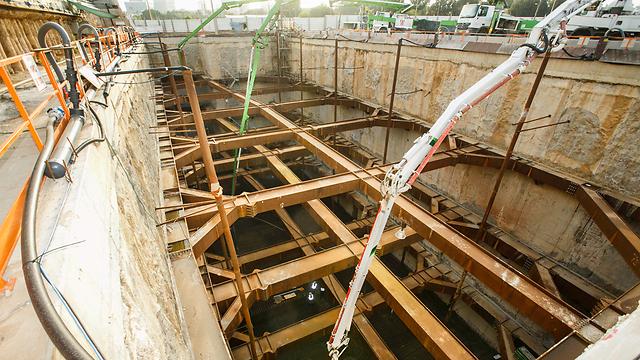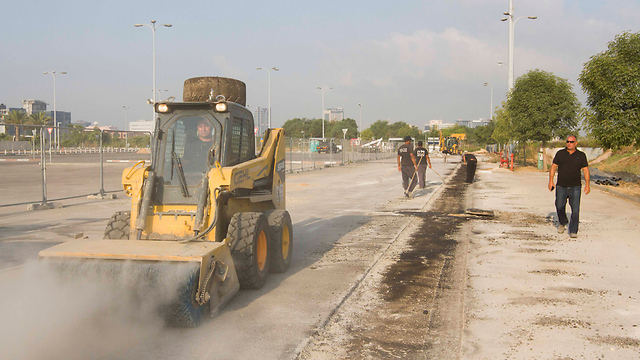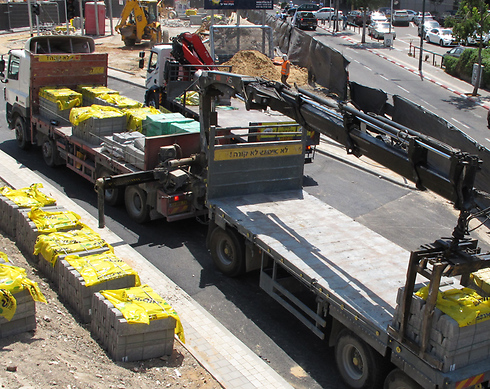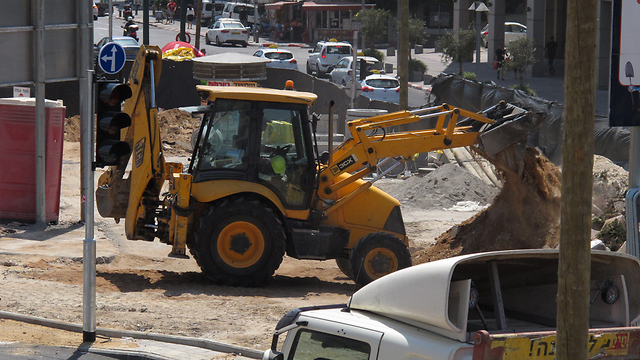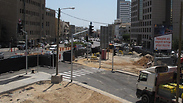
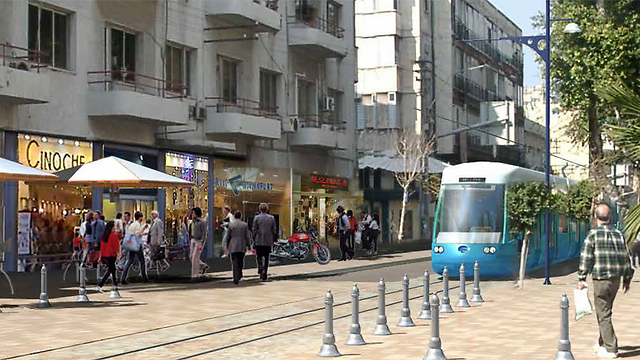
There’s a light at the end of the light rail tunnel
How bad is the construction of Tel Aviv's light rail going to be? Just ask the Jerusalemite business owners; customers stopped coming, merchants got into financial trouble, 60% of businesses closed down; but now, it appears, there's life after the digging: 'We turned into a European city. Tourists from all over the world come here'.
In a past life, it was known as the "Hava Brothers Bakery." A family business like in the old days, located at the entrance to Mahane Yehuda market, where Jerusalemite grandmothers would come with their full shopping carts at the end of their walk among the market stalls. In 2013, after the coming of the light rail, the bakery turned into the "Hava territory" - a combination of a restaurant, a café, and a bakery shop. The buns, challot, and the Jerusalem bagels were replaced by dishes like tapas of roasted beets with whipped yogurt and ricotta ravioli in tomato butter. Instead of the old regulars, there are now tourists and trendy Jerusalemites.
"The bakery was a Jerusalemite institution," says 26-year-old Assaf Carla, the manager of the Jaffa Street restaurant. "Two years ago, the owner Ofer Hava decided to replace the baked goods with a French-Jerusalemite pâtisserie, and the place became successful. A lot of people are coming here thanks to the light rail, and we can feel the upswing. People have a view of the light rail, and say they feel like they're abroad."
And what about the Jerusalemites who became addicted to your bagels?
"Most Jerusalemites prefers to shop at shopping malls now, and quite a few businesses were not able to recover. During construction (of the light rail), all of the businesses here suffered. I, as a Jerusalemite, remember being stuck in traffic for over an hour. But the light rail has been good for us, and it is worth all the suffering. There are a lot of tourists coming from both inside Israel and from abroad, and the street is busy and lively, and that's fun."
Clearing off the dust
In the four years that have passed since the light rail started operating, Jaffa Street in Jerusalem has been prospering. The same can be said for the nearby market. Stores, cafés and new restaurants have popped up on every corner. There is an upswing of construction on the street and on nearby streets. The owners of the new businesses, and those who were able to reinvent themselves, are quite pleased with the situation, but the old merchants have yet to recover from the serious blow they endured during the infrastructure work. They still call it "The Cursed Rail."
"I can't get over the ten years in which they were digging on our street and ruined our lives," says Kami Malkan, 47, the owner of the clothes store Malkan. "I've been in this store since 1981. We've experienced horrific terror attacks on Jaffa Street - suicide bombers and bombs on buses. As if that wasn't enough, right after the terror bombings, came the light rail works, and to me that was also a kind of attack. My livelihood seriously suffered. What should have lasted for several years, lasted an entire decade, and we, the business owners, paid the price."
As massive headlines announce the beginning of infrastructure work for the Tel Aviv light rail this coming Sunday, Malkan's trauma resurfaces.
"A disaster, that's what is in store for business owners in Tel Aviv," he warns.
"Hell is what will happen in the coming years," determines his neighbor, Yehezkel Menagen, 50, the owner of Chic Parisian shoe store.
"They'll experience a nightmare and daily existential anxiety," says Shimon Deutsch, 52, the chairman of the Mahane Yehuda Merchants Association.
The three of them know what they're talking about, from experience. The infrastructure work for the Jerusalem light rail started in 2000. It was supposed to end in six years, but was extended in five additional years.
"There was a terrible mess here that entire time," Malkan says. "They opened up the sidewalk over and over again. Laid cables for the electricity company, and closed up. Two weeks later they opened it up again to change the sewer pipes, and closed it up again. And then they opened it to put phone lines, and then water pipes. We have lived for years inside a construction site - with no paved roads or sidewalks. In the winter, I had to stand there with a mop to get all the water that got into the store out. Customers could not get to us because the bus lines that have passed here for dozens of years were cancelled. You couldn't get here with a private car either, because the parking spots were eliminated."
The construction site experience was horrifying to all of those who tried to run their businesses despite the chaos. "When the compressors were drilling in the street, the entire shop shook," Israel Daniel, the owner of "Danny Books," recalls. "There were cracks in the walls and terrible noise, to the point where you couldn't have a phone call. Every morning we wiped the layers of dust off the books and shelves and at night, when the works resumed, the dirt piled up anew. We breathed a lot of dust during those years. It was a difficult time mostly because we could not see the light at the end of the tunnel. Every time we thought that they finished a section, it turned out we were wrong because someone forgot to put in a transformer or something and the drilling and shaking started again. We were living in third world conditions, without a road or a sidewalk."
Not everyone managed to survive this reality. "Some 60 percent of the businesses on the street were closed, or their owners abandoned them and rented them out for cheap," says Eli Levy, the chairman of the City Center Traders' Union and the owner of the restaurant Eldad VeZehoo.
One of those who did not survive was Shimon Ahdut, a clothes shop owner. "I couldn't pay my debts and I gave up," he explains. "How can you pay property tax, income tax, and electricity, when you earn NIS 200 on a good day?"
"During the construction, I didn't have one good day,” says Netanel Lavtov, 42, the owner of Taquila Shoes, which has been on Jaffa Street for the past 22 years. "These ten years were detrimental to my health. I became sick with the financial pressure, from the worrying that wouldn't end. Customers were not coming, but they took property and income tax from us like clockwork, like we were on the Champs-Élysées."
Malkan is listening to Lavtov, and then joins in with his own troubles. "During that time, we lost so much money that I didn't have enough to buy food. I had six children at the time and I had to ask my parents for money. There were days when not a single person entered the store, we didn't even open the cash register. I lost my masculinity. Every day I came home sad, and felt like nothing next to my wife, because what kind of a man are you if you can't even give her NIS 100 to go to the grocery store? This situation brought us to the verge of divorce. Do you realize this? Getting a divorce because of the light rail?!"
Shimon Deutsch grew up in Mahane Yehuda market, in his father's vegetable store. Today, he manages the store. "During construction, there was a dramatic drop in profits," Deutsch says. "Market stall owners went into big debts. Some just went bankrupt, others encountered loan sharks who offered to help them pay their debts, and got into more trouble that way. I began seeing more and more people without happiness, without joy. It felt like a funeral home here. One friend of mine got diabetes, another got addicted to drugs and alcohol. I heard about couples who got divorced, about violence. They put a lot of sand and asphalt, cement and iron into this project, but they didn't think about the people - and I have a feeling the same will happen in Tel Aviv as well."
And you, did you accumulate debt?
"Yes, but I didn't turn to loan sharks. I told my wife and three children that we were dramatically lowering our standard of living. We cut back on a lot - food, shopping, after-school activities. We were fighting for survival."
Why didn't the merchants leave the street? Malkan remembers a story he heard as a child from his father, about a donkey that for years, its owners taught him the way to the field, until he just knew the way and didn't need to be taken there anymore. "I am the donkey that only knows the way to Jaffa Street," he says. "Now, I keep saying it's a shame I didn't leave here on the first day of digging. A lot of business owners took that step, and opened a business elsewhere in the city and during the ten years we've been stuck with the infrastructure work, they moved forward and we stayed stuck in one place, and even went backwards. I have no doubt that this is exactly what will happen in Tel Aviv. A large percentage of business owners will go bankrupt. If they can, they should flee, and shouldn't say that 'it's going to be okay' like we did and stay."
Shoe store owner Yehezkel Menagen stayed on the street for a different reason. "You don't leave your home," he explains. "My father opened the store in 1930. Our family survived the Turks and the British in this store and we said we'd survive Olmert as well, who was the mayor at the time. Even though Jaffa Street looked like a battle field, we came to the store every morning. My hearing was damaged because of the drilling and the digging, but I didn't give up. There were weeks in which we didn't sell a single pair of shoes, but I brought money from home to pay for new merchandise. I wanted the store to maintain the reputation we've been building for decades. I sold at loss leader pricing just so people will maintain some sort of connection to us. After analyzing the difficult situation, I decided in 2006 to open another store on Agripas Street, where the light rail won't pass. After all, we needed to make a living. We couldn't live on charity."
What is your advice to Tel Aviv business owners?
"Don't give up. It's easiest to close up shop and leave, but you have to fight for your business. Speak out and demand a reduction in taxes."
Daniel from the book store, meanwhile, says that the secret is to think creatively - both in Tel Aviv and in Jerusalem. "Since the customers wouldn't come to us, I set up a website through which they ordered books," he says. "We delivered to homes, and offered attractive prices. My brother and I took a cart filled with books to people who ordered, and they waited for us in their cars about 200 meters away. That's how we survived."
The bon vivants come in droves
The veteran merchants won't admit it, but even before tractors became part of their daily lives, Jaffa Street was dying out. The lack of parking in the area and the air pollution created by the many buses that passed through the street drove the Jerusalemites to the Malha Mall and to Talpiot's commercial center. They stopped "going into town" to shop, as they say in Jerusalem.
But as soon as the light rail started running in 2011, the street was transformed. The air pollution has been dramatically reduced. Clearing Jaffa Street of all other vehicles made the old buildings stand out in their beauty. The atmosphere on the street changed, and it now feels more like a European street. Both local and foreign tourists come here on the light rail from the entrance to Jerusalem, and after a shopping spree in the area, they head to the Old City. 140,000 people pass through the street on the light rail every day.
Arabs also visit the street more than they ever did before: Families from east Jerusalem get on the train in Shuafat or Beit Hanina and come to Jaffa Street to shop, or just sit at a café. Strangely, the light rail helps coexistence. You can find branches of chains like Cofizz and one branch of Cofix, opened until very late at night.
The market that connects to the street has also undergone a similar upgrade. It welcomes tourists with less market stalls and more restaurants and cafés. Places made famous in Yossi Banai songs like Rachmo, the Midnight Steak House and the Morduch restaurant are joined by restaurants like Machneyuda, as well as fish and chips stalls, tapas bars and burger joints.
“I opened a store specifically on Jaffa Street because I predicted the light rail will be good for the area,” says Yaniv Nachmias, 32, who opened his women’s clothes shop Tehila three years ago. “I told myself that this wouldn’t be just another clothes store, and that we’ll target the religious sector. Without having a focus, it’s hard to succeed. Today, the street is prospering. More and more people are returning, after having given up on the city center for years. On Friday, it feels like a celebration here.”
The small, old stores, most of which offer clothes and shoes at attractive prices, are slow in experiencing all of this prosperity. Few of those who enter them come out with shopping bags. “We’ve been sitting here at the store for two hours, and one person bought a shirt,” Malkan says. “Is this what you call a lively business? They tell me that thanks to the light rail, the air pollution was significantly reduced, but I miss the Jaffa Street that had cars and traffic. It brought life to the city center. The quiet of the train is for tourists, not for us.”
The boom in tourism also significantly raised the rent for the stores. “Since the light rail started running, the rent went up 30-40 percent, while sales only went up 10 percent,” Lavtov complains. And Deutsch from the vegetables store adds, “The prices here have become crazy. The rent for a 25 square meters business get to NIS 15,000-20,000 a month, but the owners of the older businesses don’t earn accordingly. The market turned into an area of partygoers, and the market stall owners feel they’re just the backdrop to that.”
Daniel from the book store refuses to partake in this misery. He insists on looking on the bright side. “Actually, four years later, I kind of forgot the suffering during the ten years of construction. It’s like a woman who gives birth – the birth itself is painful, but a new life can be pretty good. Here, at the end of the project I got a framed picture of the light rail’s maiden voyage from the CEO of the company that built it and I put it over the cash register at the store. With all of the suffering we experienced, today I am thankful for the train. It’s an amazing instrument that every European city has, and we deserve it too.”















